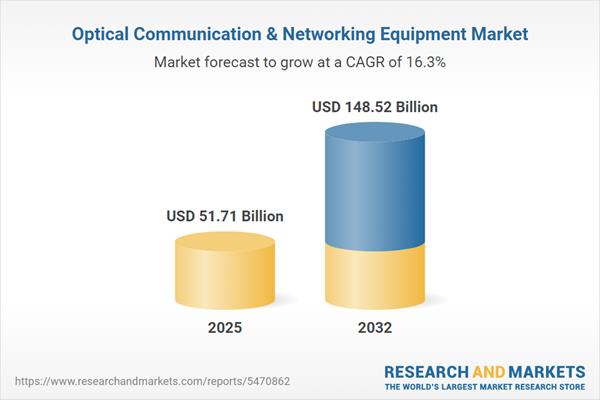Speak directly to the analyst to clarify any post sales queries you may have.
The optical communication and networking equipment market is at the center of global digital transformation, enabling organizations to enhance resiliency, adaptability, and secure operations in an increasingly connected landscape. As industries demand greater network capacity and performance, optical solutions support continued scalability and operational excellence.
Market Snapshot: Global Optical Communication and Networking Equipment Market
The global optical communication and networking equipment market currently stands at USD 44.52 billion, with projections to reach USD 51.71 billion in the next year and a compound annual growth rate of 16.25%. By 2032, market size is expected to hit USD 148.52 billion. This accelerated growth is supported by rapid advancements in enterprise digitalization and the growing need for cloud computing platforms that deliver speed and reliability. Investment in the modernization of data centers and telecom infrastructure fuels demand for next-generation networking solutions. As companies increasingly operate on data-driven models, optical networking adoption drives automation and underpins continuous, uninterrupted business operations, especially in sectors requiring mission-critical performance and robust industrial automation.
Scope & Segmentation: Optical Communication and Networking Equipment Market
This report offers executive-level intelligence across segments shaping investment, strategy, and risk management in this market. Each segment functions as a crucial driver for digital transformation, technology adoption, and infrastructure agility:
- Offering: Comprehensive coverage includes hardware, consulting, managed services, installation, maintenance, and software support, enabling organizations to prioritize end-to-end infrastructure modernization and operational support.
- Protocol: Focuses on Ethernet, Fibre Channel, Optical Transport Network, and SONET/SDH, supporting businesses with scalable networks and future-proof connectivity standards.
- Application: Addresses use cases spanning data centers, telecom evolution, IT infrastructure, and industrial automation, reflecting the migration of business-critical functions to high-reliability platforms.
- Component Type: Highlights amplifiers, multiplexers, routers, switches, and transceivers, each vital for sustaining reliable network integrity and fulfilling tailored performance objectives.
- Network Type: Covers local, metropolitan, and wide area networking needs, helping geographically distributed enterprises maintain secure and compliant connectivity.
- Data Rate: Ranges to accommodate diverse bandwidth requirements, underpinning organizational growth and supporting data-centric business strategies.
- Technology: Includes CWDM, DWDM, Passive Optical Networking, Reconfigurable Optical Add Drop Multiplexer, and Space Division Multiplexing, which are designed for efficiency and seamless scalability as capacity needs evolve.
- Form Factor: Offers modular options such as CFP, QSFP, SFP, and XFP, facilitating rapid system upgrades and accelerated technology adoption cycles.
- Regional Coverage: Analyzes markets in the Americas, Europe, Middle East and Africa, and Asia-Pacific, with special insights into strategic country dynamics in the US, Germany, China, and India.
- Key Players: Details leading companies including Huawei, Nokia, Ciena, Cisco, ZTE, Corning, Fujitsu, Infinera, ADVA, and Juniper Networks with a focus on their role in technical progression and global presence.
Key Takeaways for Senior Decision-Makers
- Optical networking solutions are becoming essential for supporting agile business operations and secure adoption of cloud and hybrid IT environments.
- Integration of advanced transceivers and software-defined networking streamlines processes and supports rapid deployment of new technology platforms.
- Sustainable procurement strategies, compliance with evolving regulations, and robust supplier networks are increasingly important for supply chain dependability.
- Automated network management and managed services help organizations optimize operational efficiency as infrastructures become more complex.
- Active engagement in open standards initiatives enhances multi-vendor interoperability, fostering seamless technology integration in expansive enterprise networks.
- Industry-focused deployments, particularly in edge computing and telecom, ensure rapid adaptation to changing market needs and regional regulations.
Tariff Impact: Strategic Adaptation of Cost Structures and Sourcing
Anticipated U.S. tariffs on optical networking products in 2025 are leading organizations to reassess global supply chain dynamics. Businesses are adopting diversification of supplier bases and evaluating regionally based assembly to mitigate regulatory and trade risks, which enhances overall reliability and reduces operational exposure.
Methodology & Data Sources
This analysis integrates in-depth industry white paper reviews and technical documentation with expertise from direct interviews with subject matter experts. Validation includes stakeholder feedback to deliver actionable, relevant insight for decision-makers navigating the optical communication and networking equipment market.
Why This Report Matters
- Enables IT leaders and procurement executives to guide network investment and compliance strategies amid rapid technological and regulatory changes in optical communications.
- Delivers actionable insights to support proactive risk management and opportunity recognition in both mature and developing markets globally.
- Supports organizations in crafting adaptive strategies that evolve in line with changing market realities, advancing infrastructure and business objectives.
Conclusion
This report equips executive teams with the insights needed to modernize network architecture, inform procurement, and support continued advancement in digital infrastructure and operational capability.
Additional Product Information:
- Purchase of this report includes 1 year online access with quarterly updates.
- This report can be updated on request. Please contact our Customer Experience team using the Ask a Question widget on our website.
Table of Contents
3. Executive Summary
4. Market Overview
7. Cumulative Impact of Artificial Intelligence 2025
Companies Mentioned
The companies profiled in this Optical Communication & Networking Equipment market report include:- Huawei Investment & Holding Co., Ltd.
- Nokia Corporation
- Ciena Corporation
- Cisco Systems, Inc.
- ZTE Corporation
- Corning Incorporated
- Fujitsu Limited
- Infinera Corporation
- ADVA Optical Networking SE
- Juniper Networks, Inc.
Table Information
| Report Attribute | Details |
|---|---|
| No. of Pages | 184 |
| Published | October 2025 |
| Forecast Period | 2025 - 2032 |
| Estimated Market Value ( USD | $ 51.71 Billion |
| Forecasted Market Value ( USD | $ 148.52 Billion |
| Compound Annual Growth Rate | 16.2% |
| Regions Covered | Global |
| No. of Companies Mentioned | 11 |









